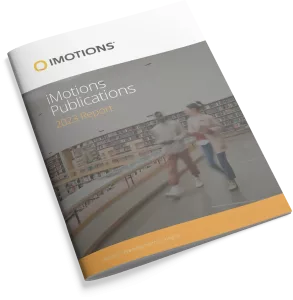-
The effect of the modality principle to support learning with virtual reality: An eye-tracking and electrodermal activity study
Virtual reality (VR) is considered a promising approach to support learning. An instructional design is essential to optimize cognitive processes. Studies show that VR has unique instructional and pedagogical requirements. To evaluate the effectiveness and applicability of the modality principle, which was previously validated in 2D classic multimedia, for learning with VR. The modality principle […] -
Cognitive behavioral therapy with adaptive virtual reality exposure vs. cognitive behavioral therapy with in vivo exposure in the treatment of social anxiety disorder
Social anxiety disorder (SAD) has a high prevalence and an early onset with recovery taking decades to occur. Current evidence supports the efficacy of cognitive behavioral therapy (CBT) with virtual reality (VR) exposure. However, the evidence is based on a sparse number of studies with predominantly small sample sizes. There is a need for more […] -
Virtual Reality images’ impact on cognition and affect in hotel promotions: Application of self-reported and psycho-physiological measures
The current study examines how two types of Virtual Reality (VR) hotel images impact cognition and affect when used for promotional purposes. The study employs psycho-physiological measurement tools along with a self-reported survey method to evaluate: (1) affective responses, (2) Cognitive Load, and (3) and attitudinal and behavioral intention responses that two types of VR […] -
Investigating the effectiveness of immersive VR skill training and its link to physiological arousal
This paper details the motivations, design, and analysis of a study using a fine motor skill training task in both VR and physical conditions. The objective of this between-subjects study was to (a) investigate the effectiveness of immersive virtual reality for training participants in the ‘buzz-wire’ fine motor skill task compared to physical training and […] -
Start Making Sense: Identifying Behavioural Indicators When Things Go Wrong During Interaction with Artificial Agents
The findings from this study will allow artificial agents to be trained to understand characteristic human behaviour exhibited during communication, and how to respond to specific non-verbal cues and biometric feedback with appropriately human-like behaviour -
Evaluation of a motorised patient transfer device based on perceived workload, technology acceptance, and emotional states
The high prevalence of musculoskeletal disorders (MSDs) among healthcare workers is partly attributed to the low adoption of patient transfer assistive devices. This study aimed to evaluate the nurses’ perceived workload, technology acceptance, and emotional states during the use of the sliding board (SB) and mechanical intervention in the form of a Motorised Patient Transfer […] -
Look Twice: A Computational Model of Return Fixations across Tasks and Species
Saccadic eye movements allow animals to bring different parts of an image into high-resolution. During free viewing,inhibition of return incentivizes exploration by discouraging previously visited locations. Despite this inhibition, here we show that subjects make frequent return fixations. We systematically studied a total of 44,328 return fixations out of 217,440 fixations across different tasks, in […] -
The face in everyday social interaction: social outcomes and personality correlates of facial behaviour
Facial behaviour is a central component of social interaction, yet is primarily studied in the absence of a social partner with a heavy focus on static, universal prototypes. Examination of individual variation in facial behaviour embedded within social interaction is essential to understand social function. We conducted a three-part multi-method study to examine how variation […] -
Affective Dynamics and Cognition during Game-based Learning
Inability to regulate affective states can impact one’s capacity to engage in higher-order thinking like scientific reasoning with game-based learning environments. Many efforts have been made to build affect-aware systems to mitigate the potentially detrimental effects of negative affect. Yet, gaps in research exist since accurately capturing and modeling affect as a state that changes […] -
Atypical Facial Expressivity in Young Children with Problematic Peer Relationships
Peer problems are frequently associated with difficulties in recognizing and appraising the emotions of others. It has been argued that facial responsiveness to others’ emotions-or motor empathy-is a precursor of emotion processing and affective empathy. Although mimicry impairments have been observed in studies of young people with conduct problems, to our knowledge no study has […]
Research Report 2024
In-depth look at the scientific landscape as powered by iMotions software, showcasing groundbreaking research and the impact of our tools in various scientific and industrial fields.

iMotions Science Resources
Looking for white papers, validation reports or research show casing iMotions Multimodal capabilities?
Share Your Research

850+ universities worldwide with an iMotions human behavior lab
73 of the top 100 highest ranked universities
710+ published research papers using iMotions
iMotions is used for some of the most interesting human behavior research studies carried out by top researchers around the world. Contact us to have your publication featured here.
The authors of these publications have used iMotions as a software tool within their research.
“Software should be cited on the same basis as any other research product such as a paper or a book; that is, authors should cite the appropriate set of software products just as they cite the appropriate set of papers” (Katz et al., 2020).
We therefore encourage you to cite the use of iMotions where appropriate.
How to cite iMotions
APA
iMotions (10), iMotions A/S, Copenhagen, Denmark, (2024).
Note: adjust the version and year where relevant.
5 Most Popular Blogs
Publications
Read publications made possible with iMotions
Blog
Get inspired and learn more from our expert content writers
Newsletter
A monthly close up of latest product and research news


